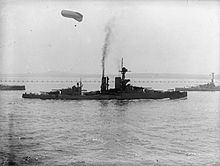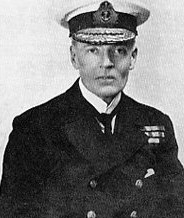Frederick Field (Admiral)
Sir Frederick Laurence Field , GCB , KCMG (born April 19, 1871 in Killarney , County Kerry , † October 24, 1945 in Escrick , North Yorkshire ) was a British naval officer in the Royal Navy , who last served as First Sea Lord between 1930 and 1933 Lord) was. In 1933 he became the Commodore (Admiral of the Fleet) transported.
Life
Training, uses as a naval officer and staff officer
Frederick Laurence Field, son of Spencer Field, Colonel (Colonel) of the Royal Warwickshire Regiment , began on 15 July 1884 as midshipman his training as a naval officer in the Royal Navy and was on 15 July 1884 for Midshipman ( Midshipman ) and on 14 November 1890 promoted to lieutenant at sea (sub-lieutenant) . On 1 April 1893 his promotion took place on Lieutenant (Lieutenant) . After various uses, he was transferred to the German Empire of China in 1900 on board the unit line ship HMS Barfleur , where he took part in the suppression of the Boxer Rebellion , was wounded in Tientsin and was mentioned in Vice Admiral Edward Hobart Seymour's war diary for his bravery ( Mentioned in dispatches ) .
On February 26, 1900 Field was promoted to frigate captain (Commander) and subsequently found numerous other uses within the Royal Navy, such as on the torpedo boat HMS Jaseur and the unit line ship HMS Albion . After being on December 31, 1907 was promoted to Captain (Captain) had received, he was first commander ( Commanding Officer ) of the Torpedo School (Torpedeo School "HMS Defiance") in Devonport and took over following between August 1910 and July 1912 be first own ship command, namely as commander of the unit ship of the line HMS Duncan . He then served between July 1912 and September 1914 as the commandant and superintendent of the Navy Signals School "HMS Mercury" .
First World War, post-war period and promotion to flag officer

At the beginning of the First World War , Captain zur See Field was in September 1914 in command of the torpedo school (Torpedo School "HMS Vernon") and held this position until September 1915. After that, between September and December 1915, he briefly acted as commandant of the battleship HMS Monarch . He then took over command of the battleship HMS King George V in December 1915 , which he held until August 1916. With this he took part in the Skagerrak Battle , the largest naval battle of the First World War between the German deep sea fleet and the Grand Fleet of the Royal Navy from May 31, 1916 to June 1, 1916 in the waters off Jutland . For his services there he was mentioned again in the war report and appointed Companion of the Order of the Bath (CB).
He then served between August 1916 and June 1918 as Chief of Staff of the Deputy Supreme Commander of the Grand Fleet (Chief of Staff to the Admiral, Second in Command, Grand Fleet ) , Vice Admiral Charles Madden . For his services in the First World War, he also received the Russian Order of Saint Anne , the Officer's Cross of the Legion of Honor , the title of command of the Order of the Crown of Romania and the Navy Distinguished Service Medal . At the end of the war he joined in June 1918 as Director of the Department of torpedoes and sea mines in the Admiralty and held this position until April 1920. took place in this use at 11 February 1919 was promoted to Rear Admiral (Rear Admiral) and on the 17th In July 1919, he was appointed Commander of the Order of St Michael and St George (CMG) for his services as Chief of Staff to the Deputy Commander-in-Chief of the Great Fleet .
In April 1920, Rear Admiral Field took over within the Admiralty by Rear Admiral William Nicholson function as Third Sea Lord (Third Sea Lord and Controller of the Navy) and was until his replacement by Rear Admiral in this Cyril Fuller in May 1923 in charge of procurement and defense matters Royal Navy. On January 1, 1919, he was beaten Knight Commander of the Order of the Bath (KCB) and has since had the addition of "Sir".
Ascent to First Sea Lord and Admiral of the Fleet
On May 15, 1923 Rear Admiral Frederick Field replaced Rear Admiral Walter Henry Cowan as commander of the Battle Cruiser Squadron and had this post with the battle cruiser HMS Hood as the flagship until January 1925, whereupon Rear Admiral Cyril Fuller was his successor again. During this time, between November 1923 and September 1924, he undertook a world tour (The Empire Cruise) as the commander of a special service squadron consisting of the battle cruisers HMS Hood , HMS Repulse and the light cruisers HMS Delhi , HMS Dauntless , HMS Danae , HMS Dragon and HMS Dunedin . For his achievements in this world trip he was on 26 September 1924 Vice Admiral (Vice Admiral) transported at the same time also for Knight Commander of the September 26, 1924 Order of St Michael and St George defeated (KCMG).
In May 1925 Vice Admiral Field took over the post as Deputy Chief of the Naval Staff , succeeding Vice Admiral Roger Keyes . He remained in this use until his replacement by Vice Admiral William Wordsworth Fisher in May 1928 and also acted as one of the Lord Commissioners of the Admiralty . After April 5, 1928 Admiral had been promoted, he pulled on 1 May 1928 again Admiral Roger Keyes from, this time as the Supreme Commander of the Mediterranean Fleet (Commander-in-Chief, Mediterranean Fleet ) with the battleship Queen Elizabeth or later the battleship HMS Warspite as the flagship. He remained in this role until April 1930, when Admiral Ernle Chatfield was his successor.
Recently joined Admiral Frederick Laurence Field on July 30, 1930, the successor to Admiral of the Fleet Charles Madden, 1st Baronet as First Sea Lord (First Sea Lord) and at the same time as Chief of Naval Staff (Chief of the Naval Staff) on. He held these functions until he was replaced by Admiral Ernle Chatfield in January. During his tenure as First Sea Lord came on for -Invergordon Mutiny , a two-day mutiny by British sailors of the Atlantic Fleet ( Atlantic Fleet ) on 15 and 16 September 1931. As the first Sea Lord, he also belonged to the Committee of Imperial Defense to, a major British government body of top politicians and military personnel to plan the strategic defense policy of the British Empire . He suffered from the effects of a gastric perforation . He was on 21 January 1933 with the rank of Fleet Admiral (Admiral of the Fleet) to retire (Retired List) adopted and retired from active military service. On June 3, 1933, he was the Grand Cross ( Knight Grand Cross ) awarded the Order of the Bath (GCB). He also served as chairman of the Royal Navy Club between 1935 and 1937 .
Field had been married to Annie Norrington Harris since 1902 and died on October 24, 1945 of complications from cancer .
Web links
- ADMIRAL OF THE FLEET SIR FREDERICK LAURENCE FIELD, GCB, KCMG (Royal Naval Flagg Officers 1904–1945)
- Royal Navy (RN) Officers 1939-1945
- ROYAL NAVY SENIOR APPOINTMENTS
- CAPTAINS COMMANDING ROYAL NAVY WARSHIPS
Individual evidence
- ↑ London Gazette . No. 26286, HMSO, London, May 10, 1892, p. 2704 ( PDF , accessed December 29, 2018, English).
- ↑ London Gazette . No. 26388, HMSO, London, April 4, 1893, p. 2078 ( PDF , accessed December 29, 2018, English).
- ↑ London Gazette . No. 27235, HMSO, London, October 5, 1900, p. 6104 ( PDF , accessed December 29, 2018, English).
- ^ London Gazette (Supplement). No. 27448, HMSO, London, June 24, 1902, p. 4198 ( PDF , accessed December 29, 2018, English).
- ↑ London Gazette . No. 28096, HMSO, London, January 3, 1908, p. 34 ( PDF , accessed December 29, 2018, English).
- ↑ CAPTAINS COMMANDING ROYAL NAVY WARSHIPS , p. 53
- ↑ ROYAL NAVY SENIOR APPOINTMENTS , p. 208
- ↑ ROYAL NAVY SENIOR APPOINTMENTS , p. 205
- ↑ CAPTAINS COMMANDING ROYAL NAVY WARSHIPS , p. 65
- ↑ CAPTAINS COMMANDING ROYAL NAVY WARSHIPS , p. 67
- ^ London Gazette (Supplement). No. 29751, HMSO, London, September 15, 1916, p. 9064 ( PDF , accessed December 29, 2018, English).
- ↑ ROYAL NAVY SENIOR APPOINTMENTS , p. 32
- ↑ London Gazette . No. 31201, HMSO, London, February 25, 1919, p. 2738 ( PDF , accessed December 29, 2018, English).
- ^ London Gazette (Supplement). No. 31461, HMSO, London, July 15, 1919, p. 9107 ( PDF , accessed December 29, 2018, English).
- ↑ ROYAL NAVY SENIOR APPOINTMENTS , p. 6
- ↑ KNIGHTS AND DAMES (leighrayment.com)
- ^ London Gazette (Supplement). No. 32782, HMSO, London, December 29, 1922, p. 2 ( PDF , accessed December 27, 2018, English).
- ↑ ROYAL NAVY SENIOR APPOINTMENTS , p. 158
- ↑ London Gazette . No. 32981, HMSO, London, October 10, 1924, p. 7327 ( PDF , accessed December 27, 2018, English).
- ↑ KNIGHTS AND DAMES (leighrayment.com)
- ↑ London Gazette . No. 32978, HMSO, London, September 30, 1924, p. 7101 ( PDF , accessed December 27, 2018, English).
- ↑ ROYAL NAVY SENIOR APPOINTMENTS , p. 11
- ↑ London Gazette . No. 33376, HMSO, London, April 17, 1928, p. 2740 ( PDF , accessed December 29, 2018, English).
- ↑ ROYAL NAVY SENIOR APPOINTMENTS , p. 108
- ↑ ROYAL NAVY SENIOR APPOINTMENTS , p. 2
- ↑ London Gazette . No. 33905, HMSO, London, January 24, 1933, p. 524 ( PDF , accessed December 29, 2018, English).
- ↑ KNIGHTS AND DAMES (leighrayment.com)
- ^ London Gazette (Supplement). No. 33946, HMSO, London, June 2, 1933, p. 3801 ( PDF , accessed December 29, 2018, English).
- ↑ CHAIRMEN OF THE ROYAL NAVY CLUB
| predecessor | Office | successor |
|---|---|---|
| Sir William Nicholson |
Third Sea Lord 1920–1923 |
Sir Cyril Fuller |
| Sir Walter Henry Cowan | Commander, Battlecruiser Squadron 1923–1925 |
Sir Cyril Fuller |
| Sir Roger Keyes | Deputy Chief of the Naval Staff 1925–1928 |
Sir William Wordsworth Fisher |
| Sir Roger Keyes | Commander-in-Chief, Mediterranean Fleet 1928-1930 |
Sir Ernle Chatfield |
| Charles Madden, 1st Baronet |
First sea lord 1930–1933 |
Sir Ernle Chatfield |
| personal data | |
|---|---|
| SURNAME | Field, Frederick |
| ALTERNATIVE NAMES | Field, Sir Frederick Laurence (full name) |
| BRIEF DESCRIPTION | British Admiral of the Fleet and First Sea Lord |
| DATE OF BIRTH | April 19, 1871 |
| PLACE OF BIRTH | Killarney , County Kerry , Ireland |
| DATE OF DEATH | October 24, 1945 |
| Place of death | Escrick , North Yorkshire , England |

